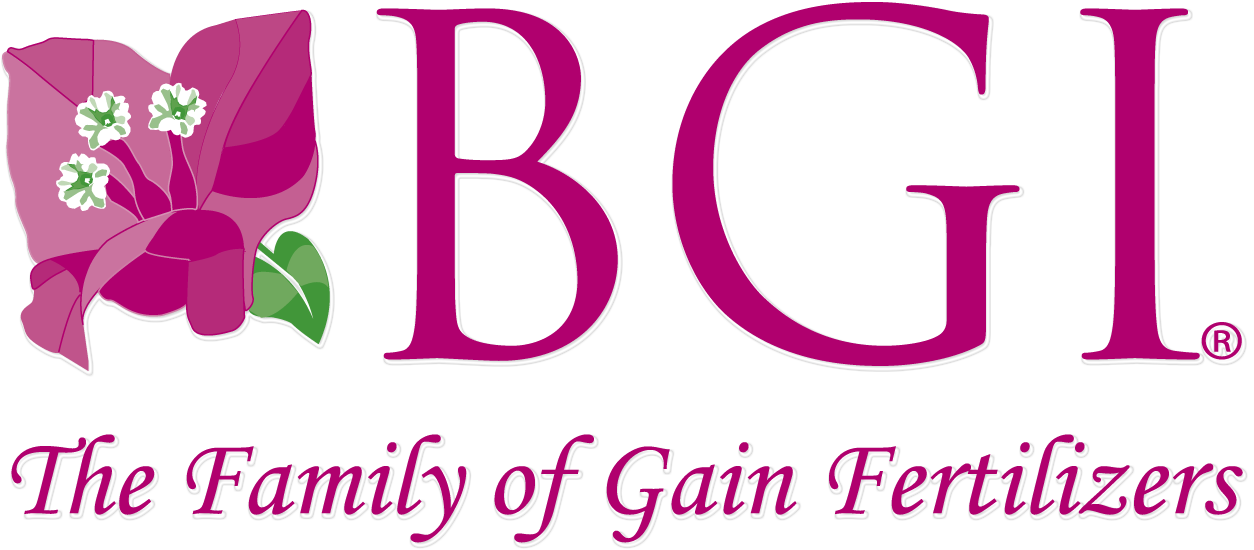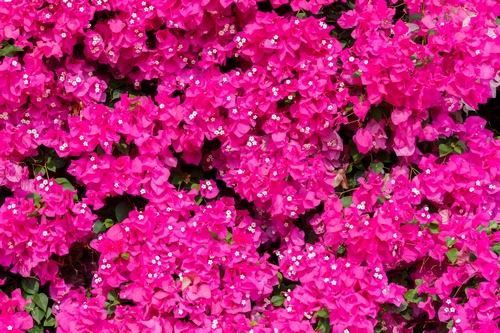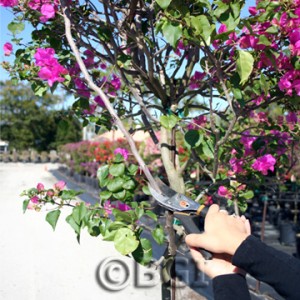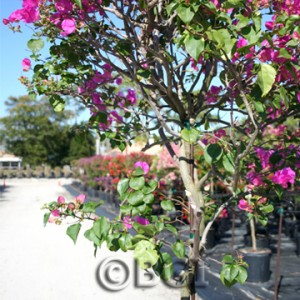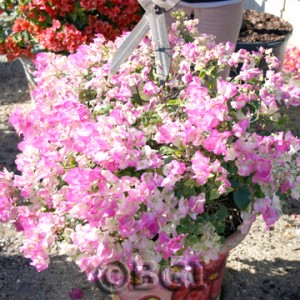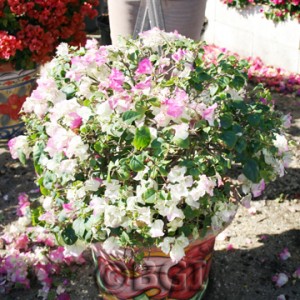Introduction
bou·gain·vil·le·a [boo-guhn-vil-yuh; -vil-ee-uh; boh-]
The Bougainvillea is an immensely showy, floriferous and hardy plant. Virtually pest-free and disease resistant, it rewards its owner with an abundance of color and vitality when it is well looked after. The bougainvillea’s versatility is legendary. It can be coaxed into a small manageable pot plant or a sizeable tree, to spread itself vertically on a wall, or climb up a trellis and form a luscious crown or burst forth into graceful arches. It makes one of the best hedges, bushes, and curb-liners. And as for bonsai or topiary purposes, it has few equals, lending its complex branching to the pruning shears, which promote even more unique and graceful forms. It is probably true to say that without the bougainvillea, our roads, parks, and private gardens would be a lot less colorful that what we see today. Almost everywhere we go, its brilliant hues and cheerful bursts punctuate the lush green mantle that cloaks our tropical environment. Other flowering plants certainly pale in comparison. [1]
Along with palms, sunshine, and beaches, the cascading blooms of bougainvillea provide one of Florida’s signature tropical images. As a profuse bloomer, bougainvillea is most striking during the winter, when it is at its peak and few other plants are able to provide color. Although it is frost-sensitive and hardy in zones 9b and 10, bougainvillea can be used as a houseplant or hanging basket in cooler climates. In the landscape, it makes an excellent hot season plant, and its drought tolerance makes bougainvillea ideal for warm climates year-round. Native to the coasts of Brazil, bougainvillea has a high salt tolerance, which makes it a natural choice for south Florida and other coastal regions. As a woody clambering vine, bougainvillea will stand alone and can be pruned into a standard, but it is perfect along fence lines, on walls, in containers and hanging baskets, and as a hedge or an accent plant. Its long arching branches are thorny, and bear heart-shaped leaves and masses of papery bracts in white, pink, orange, purple, and burgundy. Many cultivars, including double flowered and variegated, is available. [2]
History of Bougainvillea
A native to coastal Brazil, the bougainvillea was discovered in 1768 in Rio de Janeiro by French naturalist Dr. Philibert Commerçon (also sometimes spelled Commerson). The plant is named after his close friend and ship’s admiral Louis-Antoine de Bougainville, who commanded the ship La Boudeuse that sailed around the world between 1766-1769, and in which Commerçon was a passenger.
Twenty years after Commerçon’s discovery, it was first published as ‘Buginvillea’ in Genera Plantarium by A.L. de Jusseau in 1789. The genus was subsequently split in several ways until it was finally corrected to ‘Bougainvillea’ in the Index Kewensis in the 1930s. Originally, B. spectabilis and B. glabra were hardly differentiated until the mid 1980s when botanists recognized them to be totally distinct species. In early 19th century, these two species were the first to be introduced into Europe, and soon, nurseries in France and England did a thriving trade providing specimens to Australia and other faraway countries. Meanwhile, Kew Gardens distributed plants it had propagated to British colonies throughout the world. Soon thereafter, an important event in the history of bougainvillea took place with the discovery of a crimson bougainvillea in Cartagena, a Spanish port in the Mediterranean, by Mrs. R.V. Butt. Originally thought to be a distinct species, it was named B. buttiana in her honour. However, it was later discovered to be a natural hybrid of a variety of B. glabra and possibly B. peruviana – a “local pink bougainvillea” from Peru. Natural hybrids were soon found to be common occurrences all over the world. For instance, around the 1930s, when the three species were grown together, many hybrid crosses were created almost spontaneously in East Africa, India, the Canary Islands, Australia, North America, and the Philippines.[1]
Species and Hybrids
Scientific classificationKingdom - Plantae
Division - Magnoliophyta
Class - Magnoliopsida
Order - Caryophyllales
Family - Nyctaginaceae
Genus - Bougainvillea
Species - Bougainvillea spectabilis
Bougainvillea glabra
Bougainvillea peruviana
Cultivar (or variety)
Bougainvillea spectabilis is a large climber with distinctive curved thorns, and hair on stems and leaves. The bracts are crinkled, fairly large, egg-shaped, and possess colors in the rose, rusty-red, and purple. Flowers are cream in color, slender, with very hairy tubes. Leaves are large, ovate to rounded, leathery in texture and hairy underneath. The bark is pale and corky. Branching is close and short, giving rise to a very dense plant. The first species collected, it was described from dried specimens by Willdenow (1798).
Bougainvillea glabra has thinner branches that spread in many directions and have distinctive pointed triangle-shaped bracts that come in a range of whites, lilacs, mauves, and purples. Thorns are short, thin, and curved at the tips. Leaves are fairly evenly elliptical, widest about the middle. The small cream flowers are relatively big and tube-shaped. The also tend to flower virtually continuously, and often down the entire length of the branch. Originally described and named by Choisy (1849).
Bougainvillea peruviana has a branching habit that is looser and more open. This is a climbing, spiny, spreading shrub with greenish bark. Thorns (spines) are thin, straight in youth and curved when older. Leaves are thin and ovate to broadly ovate. The small roundish bracts, usually in light to dark magenta colors, are quite delicate to the touch, and are crinkly in appearance. Flowering is recurrent after strong vegetative growth in response to dry weather. This species was described and named by Humbold and Bonpland (1808).
Bougainvillea hybrids found today have been grouped into these three hybrid groups:
- B. x buttiana (glabra x peruviana)
- B. x spectoperuviana (spectabilis x peruviana)
- B. x spectoglabra (spectabilis x glabra)
Growth Cycles
The bougainvillea has two distinct growth cycles:
-
- A vegetative growth period for several weeks — when new leaves and stems grow. If the plant receives enough sunlight, the plant will form buds during this time. If there is not enough sunlight, the plant will remain in vegetative cycle and not progress to the blooming period. This is usually the case if bougainvillea are grown as houseplants or brought indoors to winter-over.
- A blooming period of several weeks when little or no vegetative growth occurs. The length of time they will display color is dependent upon the health of the plant and the environment they are in; the more sun and heat, the better. With at least 5 hours of direct sunlight per day, a typical, healthy bougainvillea will remain in a blooming period for 3 to 5 weeks.
Flowering Season
Bougainvilleas’ natural habitat is equatorial where day and night lengths are almost equal. Bougainvillea in these areas (Singapore, Brazil, Kenya to name a few) tend to bloom year round, but in North America, the best flowering occurs when the night length and day length are almost equal (in Spring or Fall). If you live in the northern states, it’s too cold to grow bougainvillea in the Fall unless they’re housed in warm greenhouses – in which case you can enjoy colorful, blooming bougainvillea in October if you wanted! So depending on which continent or region you reside, it may not be the ideal blooming season for your area. Just because it’s hot doesn’t necessarily mean that it’s flowering season for bougainvillea. Case in point, bougainvillea do not bloom well in South Florida during the summer months (June – August) because of the long days and excessive rainfall. For those of us lucky enough to call South Florida home, you already know that the coolest months of the year (October through March) have the most spectacular show of bougainvillea.
Climate
Bougainvillea are tropical and must be protected from frost. In Zone 8 and cooler, you are almost limited to growing them in some kind of container unless you treat them as an annual (plant a new plant outdoors each year). Bougainvillea thrives in full sun. At least 5 hours a day of direct sunlight is the minimal light required for good bloom. More hours of direct sun are better. Less than 5 hours and the plant may not bloom very well. If grown indoors, in shade or partial shade, you will have nice vegetative growth, but little or no bloom. If possible, keep your bougainvillea outdoors, and keep in mind that southern exposure is ideal. If placed on a covered porch, screened-in patio or balcony, where the plant receives at least 5 hours of sun each day (afternoon sun is best), then you should see adequate blooms.
Light Levels
As a tropical plant, Bougainvillea requires full sun, or a light level of at least 4000 f.c.
Soil
Bougainvillea has an extremely fine root system, and should be planted in well-drained soils. Avoid soil mixes with high peat levels and water retention. These types of media retain too much water and will contribute to root rot; be sure to select a well-draining media.[2] The best growing mixture is one that is soil-less. Soil-less media are free of any disease pathogens, insect pests, and weed seeds. They are also generally lightweight and porous, allowing for a well-drained yet moisture-retentive mix. Premixed growing media are available from garden centers. However, be careful not to use peat or peatlite mixes alone. By themselves, these media tend to become compacted, too lightweight, and hard to wet. The greatest problem with peat/peatlite mixes is when the soil dries completely, the root ball will pull away from the side of the pot, and it is almost impossible to completely wet the soil again — the water simply runs down the side of the container and drains out the bottom. If your plant dries out and you use this type of mix, to re-wet it, let the pot sit in a pail of water until the soil ball is completely wet. Before using your mix to re-pot plants, be sure it is damp. Totally dry soil mixture is difficult to handle and may damage tender roots before the plant is watered.[4]
Fertilization
Bougainvillea are heavy feeders that require regular monthly fertilization during blooming season. Nitrogen and phosphate are critical to flowering, but do not over-fertilize with these two elements because it will add growth and inhibit blooming. This is the case when using generalized fertilizers like a 20-20-20 or 12-12-12. That’s why we’ve created a blooming fertilizer specifically for bougainvillea called BOUGAIN®. With Bougain’s 6-8-10 plus Minors formula, Nitrogen levels are just right for flowering, but low enough to limit excessive green growth. In addition, Bougain® contains 5% Iron — the secret for vibrant, beautiful color on bougainvillea.
Salt Tolerance of Bougainvillea
Good salt tolerance. [3]
pH Preference of Bougainvillea
Bougainvillea does best with a soil pH of 5.5-6.5
Trimming, Pruning, and Pinching
What is the difference between trimming, pruning, and pinching a bougainvillea?
The dictionary defines them as:
- Prune: To cut or lop superfluous or undesired twigs, branches, or roots from.
- Trim: To put into a neat or orderly condition by clipping, paring, pruning, etc.
- Pinch: To remove or shorten (buds or shoots) in order to produce a certain shape of the plant, improve the quality of the bloom or fruit, or increase the development of buds.
As you can see, pruning your bougainvillea is also an act of trimming it. Confused yet? Don’t be. Throughout our website and when responding to your questions in the forum, BGI uses “pruning” and “trimming” quite differently.
Pruning
When BGI writes about pruning a bougainvillea, we mean the act of removing entire branches or major structural parts of the plant. This could be anywhere from several inches to several feet depending on the size of your bougainvillea. Pruning is performed with pruning shears. Pruning a bougainvillea is recommended when entire branches are deterring from the overall shape of the plant, or jeopardizing the structural integrity of the bougainvillea.
Trimming
When BGI writes about trimming a bougainvillea, we mean removing just the ends of branches or shoots. This could be anywhere from an inch to several feet, depending on the size of your plant. Trimming can be performed with hedge shears – either hand-held or electric & gas powered for very large plants. Hand-held hedge shears are recommended for a clean edge and for precise trimming. For professional landscapers trimming miles of bougainvillea, gas-powered hedge shears are very efficient, and get the job done nicely.
Pinching
When BGI writes about pinching, we mean removing just the very tip of new shoots. Since new shoots are only a few inches in length (that goes for all sizes of bougainvillea), pinching the tip requires removing just an inch or less. New shoots are usually green, soft, pliable, contain tiny leaves or the beginning formation of a bud at the very tip, and ‘snaps’ off easily when pinched. Pinching is usually performed by hand. It can also be done simultaneously while trimming – for any act of removing the tip of new shoots is called pinching, whether by hand or cutting tool. If you do not want to trim your bougainvillea and only want to pinch it, it will have to be done with a pair of compact hand shears or by hand. Wearing gardening gloves is recommended when pinching by hand.
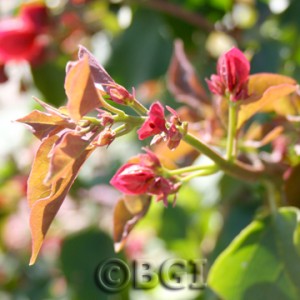
PINCHING, STEP 1: Identify new shoots. New bougainvillea shoots are green, pliable, and contain immature leaves and buds at the very tip. 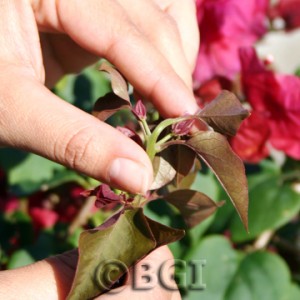
Using thumb & forefinger, bend the very tip of the shoot (approximately 1 inch). 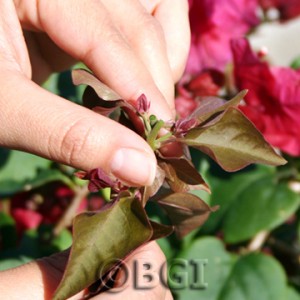
Continue to bend the tip until it snaps off completely. 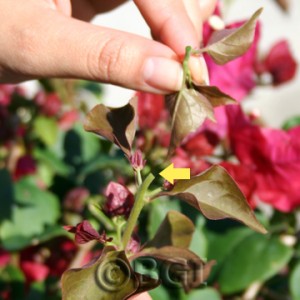
Discard the removed tip. A new shoot will pinch off easily with a clean break.
Bougainvillea may be pruned, trimmed, and pinched at any time of the year. Bloom initiation does not depend upon trimming – a bougainvillea has a bloom cycle followed by a rest period whether trimmed or not. However, trimming or pinching is recommended after the end of each blooming cycle or at the beginning of the rest period to promote branching and budding for the next bloom cycle. A bougainvillea, like most vining-type plants, will continue to grow outward without sending out side branches from each leaf-bud point unless the stem is trimmed or pinched. If you want one long stem, then don’t pinch out the tip. By pinching out the tip, most bougainvillea cultivars will send out new stems from 2 to 3 leaf-buds below the cut, giving you a fuller plant with more buds. Some varieties do not send out any new stems, so their appearance is always stringy or bare. So it is important when growing a bougainvillea, not to wait for the branches to grow very far beyond your desired size before you remove all the tips – either with shears or hand-pinching — otherwise, the growth will be bare in the center of the plant, and the overall look will be misshapen.
Planting In Containers
Generally, bougainvillea can be grown in anything that will hold soil and allow proper drainage. Some of the more traditionally used containers include terra cotta (clay) pots, plastic pots, hanging baskets, wire baskets lined with sphagnum moss or fibrous liners, concrete planters, planter boxes, and bushel baskets. When BGI was on a bougainvillea exploration trip through Southeast Asia, we saw beautiful bougainvillea growing out from old laundry baskets and tires! Just remember that the container MUST have proper drainage. If you place your pot directly on the ground, the roots may emerge from drainage holes and find their way into the earth. To prevent this, place wooden slats or four bricks (in a T-design) under the pot. The air will naturally prune the roots that are exposed.
It’s very important to remember that a bougainvillea does not tolerate standing in water. Whatever container you choose, consider these tips:
-
- Drainage: Bougainvillea must have it.
- Insulation: Avoid using black containers in full sun.
- Large enough: The container must be large enough to hold the minimum amount of soil required for mature plants to grow in.
- Weight: Will it be too heavy to move? Use broken pieces of clay pots or recycle styrofoam packing peanuts to line the bottom of the container rather than filling it fully with soil mix. This should also help with drainage and keeping drainage holes clear of debris.
Repotting Bougainvillea
A bougainvillea blooms best when pot-bound so do not be tempted to re-pot unless you must. It is best to leave the plant in its original container until the roots have replaced all of the soil and you can’t keep the plant well watered. For example, it is not unusual to grow a bougainvillea in a 1 gallon pot for three or more years. When it is necessary to re-pot remember that a bougainvillea has a very delicate root system and a fragile root to stem connection. Handle bougainvillea with care. Root pruning is not recommended when re-potting bougainvillea – in fact, disturb the roots as little as possible because the plant might go into shock and take weeks to recover. Bougainvillea love to be pot-bound, so pot in the smallest container available for the purpose you desire. Re-pot into larger pot sizes gradually. For example, move a plant in a 6″ pot into a 9″ or 10″ pot. Several years later, you can then move up to a 14″ pot. The root system needs time to grow into each new pot.
Frost Tolerance
Bougainvillea require winter protection when temperatures fall below freezing (32F), and in some cases below 40F if there is accompanying wind. A light frost will not kill a mature bougainvillea, but may for a young planting. As quickly as one day or up to one week after the frost, it is normal for all the bougainvillea leaves and bracts to drop. Any remaining foliage on the plant may have brown or black edges to them, giving them a burnt appearance. We call this tip-burn or frost-burn. Cold winds have “burned” the leaves that have lost too much water through transpiration. In this case, the plant will re-grow, but only if not subjected to further frosts for longer durations.
Winter Protection
You have two options when deciding what to do with your tropical bougainvillea in times of frost or freeze. Both options give you about the same level of success rate – moderate to high. The more mature and healthy the plant…the better chances of survival during Winter months.
Wintering Over Bougainvillea Indoors
For bougainvillea in pots, they can be wintered over in basements, garages, or other cool and lower light areas. Under these conditions they go into a dormancy state and defoliate. Occasional watering during dormancy (once or twice a month) is needed until they start to grow again in the Spring where they once again need to be moved into high light. The other option is not to force them into a dormancy state, and place them indoors on a sunny south facing windowsill. You will have to water them more frequently – about as often as a houseplant – and they probably will not have any color. You may see a bract or two sporadically appear, but more likely than not, it will look like a common green houseplant until spring when you can place it outdoors into high light.
If you have planted your bougainvillea in the soil outdoors and want to dig it up and move it indoors for the winter, expect the plant to go into dormancy sooner than if it had been in a container — the root damage as a result of digging will be the cause rather than the cool weather — but the plant should survive this kind of transplanting. Make sure to dig as far away from the root system as you possibly can. It’s important not to sever the roots; take care to dig up the entire root ball and especially in one piece.
For both options, after you bring it back outdoors in the Spring, prune back any dead or damaged stems, and begin watering and fertilizing again. Gradually increase light levels by placing in partial shade for the first few days and working up to direct sunlight by the second week.
Winter Protection for Outdoor Bougainvillea
When bougainvillea are planted in the landscape and cannot be moved, you can protect it by covering and applying water or heat. Cover bougainvillea and the surround soil around the plant with thermal covers made for plants – aka. plastic sheeting, frost cloths. A trick for applying heat is to drape lit, outdoor holiday lights prior to covering with thermal covers. Do not use lights without a cover! If the plant is left exposed to the wind, the heat from the light will dry out the plant even further. Use lights and covers only at the coldest and windiest times of day/night. Turn off lights and uncover when threat of frost is over. Keep outdoor bougainvillea well watered in frost or freezing weather. Frost injury occurs when ice crystals form on the leaf surface drawing moisture from the leaf tissue. The damage from this dehydration will be less severe if the plant is not already drought-stressed.
Sources:
[1] Simon, Eric. “Brighten Up With Bougainvillea” 2005
[2] Schoelhorn, Richard and Alavrez, Erin.
“Warm Climate Production Guidelines for Bougainvillea”.
University of Florida/ IFAS Extension. October 1, 2002.
[3] Knox, Gary W. and Black, Robert J.
Salt Tolerance of Landscape Plants for South Florida. Table 5. Salt Tolerance of Vines.
University of Florida/ IFAS Extension. Reviewed March 2000
[4] Braswell, Gordon. “Gordon Braswell’s Bougainvillea Information”.
Click here to change this text

